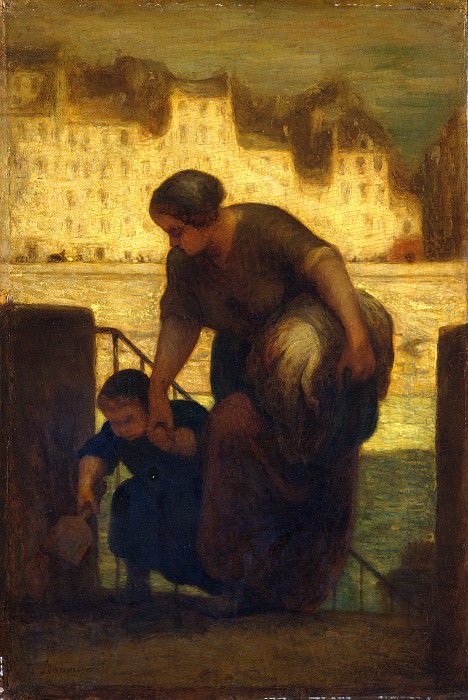Honoré Daumier – The Laundress Metropolitan Museum: part 2
Metropolitan Museum: part 2 – Honoré Daumier - The Laundress
Edit attribution
Download full size: 2462×3686 px (3,7 Mb)
Back to album: Metropolitan Museum: part 2
The hard work that takes the strength and health of young women was described by Honoré Daumier in his creations. Living on the island, he constantly had to observe this daily women’s work. Severely experiencing the hardships of the poor people, Daumier could not be indifferent, an outside viewer, however, there was nothing to help. These experiences have led to a series of paintings, where the heroines with dignity and nobility carry their heavy cross. "The Laundress" was painted in 1861, and the painter was able to so brightly and monumentally convey the female image that society compared this picture with sculptures by Michelangelo. In the painting, a young yet not old woman is climbing a high staircase with her young son.
Description of the painting "The Laundress" by Honoré Daumier
The hard work that takes the strength and health of young women was described by Honoré Daumier in his creations. Living on the island, he constantly had to observe this daily women’s work.
Severely experiencing the hardships of the poor people, Daumier could not be indifferent, an outside viewer, however, there was nothing to help. These experiences have led to a series of paintings, where the heroines with dignity and nobility carry their heavy cross.
"The Laundress" was painted in 1861, and the painter was able to so brightly and monumentally convey the female image that society compared this picture with sculptures by Michelangelo.
In the painting, a young yet not old woman is climbing a high staircase with her young son. The bale of wet laundry rolls ever lower from the gravity, her large, strong hands are reddened by the cold water, but that is not what the woman cares about now. You can see that the boy is struggling to climb the steps, and his mother supports him with a word.
Patience, calmness and care - this colors the entire image of the woman. No grueling work, no poverty and savage fatigue does not drown out these maternal qualities in a real woman. The most unbearable conditions, as if, recede into the background, the main value of life - this baby, his little joys or sorrows. Yes, and the baby itself, it can be seen that tired.
The theme of mothers always worried the artist, he was perplexed by the strength of feeling of poor women - to the exhaustion of working in harsh conditions, women were able to remain gentle, anxious and affectionate mothers retained such qualities as dignity, nobility, real beauty.
The background of the painting is highlighted by light tones, which makes the figure of the washerwoman look even more powerful, strong and majestic. It is the majesty of the simple woman that Daumier wanted to emphasize, and he succeeded.
Кому понравилось
Пожалуйста, подождите
На эту операцию может потребоваться несколько секунд.
Информация появится в новом окне,
если открытие новых окон не запрещено в настройках вашего браузера.
You need to login
Для работы с коллекциями – пожалуйста, войдите в аккаунт (open in new window).




















You cannot comment Why?
The setting is crucial to understanding the work. Behind them rises a dense block of buildings, rendered with muted tones and a lack of distinct architectural detail. This suggests an anonymous urban environment, likely representing a working-class district. The water itself acts as both a functional element for laundry and a visual barrier separating the figures from the viewer, creating a sense of distance and observation.
The palette is dominated by earthy browns, grays, and muted yellows, contributing to a somber and realistic atmosphere. Light falls unevenly on the scene, illuminating the woman’s face and hands while leaving much of the background in shadow. This selective illumination draws attention to the figures labor and their physical condition.
Subtleties within the painting hint at broader social commentary. The woman’s downcast gaze suggests a sense of resignation or perhaps quiet defiance. The child, mirroring her posture, seems already accustomed to this form of work. The overall impression is one of hardship and perseverance in an environment that offers little comfort or ease. The scene evokes themes of poverty, the burden of labor, and the cyclical nature of social disadvantage within an urban setting. It’s a portrait not just of individuals, but also of a class and its struggles.